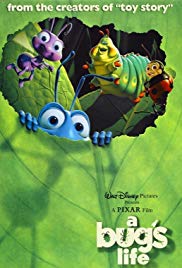CONVERSATION STARTERS
Which character was your favorite? — If you could have any of the characters in the movie as a friend, which would you choose? — Why is that?
→ Always encourage your child to form opinions and to share them.
→ Open-ended questions will help get a discussion going.
What did Flik contribute that was helpful to the colony?
Who were some small bugs in the movie that made a big difference?
What would have happened to the ant colony without Flik?
→ Just talking with your child fosters verbal, social and emotional learning.
→ Exercise memory skills by asking about the story, the characters, and the plot. Keep it light and fun.
Even someone who is small can be part of the team and make a big difference. Have you ever seen an example of that?
→ Young children love Story Time.
DISCUSSIONS BASED ON THEMES IN THE MOVIE
Select questions appropriate for your child.
1. Did the ant colony free itself from the domination of the grasshoppers because of Flik alone, or did all of the ants have to work together? Why is working together important? Talking About It — No single ant could beat all those grasshoppers. Flik tried to stand up to them at first, but he was alone, and he lost. By rallying the ants and enlisting the help of the Circus Bugs, Flik and the other ants were able to create a plan (the bird made of leaves), trick the grasshoppers, and defeat them. Another example of working together is when Dot and the Blueberry Scouts teamed up to make the bird fly.
→ When a parent takes a concept from the movie seriously, a child will start thinking about the lessons of the film. Often, it only takes one comment to start a child’s mind going.
2. Flik made a big mistake when he accidentally knocked over the food the ants had been collecting. What did he do when he made this mistake? Talking About It — He tried to tell the princess so that everyone would know what had happened and so that it could be corrected, if possible. Talk to your child about how everybody makes mistakes. Share some of your own experiences, especially events that occurred when you were young. Talk about how it made you feel and ask how your child feels when he or she makes a mistake. Discuss why it is important to report the mistake, fix it, if possible, and say that you’re sorry. Talk about how most mistakes will be forgiven, just like Flik’s, if you are honest about it.
→ You can talk about a movie at any time: right after it is over, in the car on the way to school, during quiet time, or before bed.
3. Flik made another mistake in this movie, when he mistook the Circus Bugs for warriors. This mistake he tried to hide. Was this the right thing to do? Talking About It — When you make a mistake the right thing to do is to admit it and try to correct what has gone wrong. Lying and trying to avoid responsibility for a mistake usually leads to other problems that are more serious than the original mistake. Often, the lie itself is more hurtful to your family than the original mistake. In this movie, Flik was very lucky that he was able to avoid some very bad consequences for lying and trying to avoid responsibility for his mistake. Real life is usually not so forgiving.
→ Don’t feel obligated to cover everything in this Guide. One or two questions are all that some children will tolerate. However, if your child watches the movie more than once, on each occasion start a new conversation or pick a new activity. This will enhance verbal development and increase the number of lessons your child takes from the film.
4. The ant colony was not very nice to Flik in the film. Should he have continued to help the colony? Talking About It — Yes, because the colony was his community, his home. Ants can’t survive on their own. People can sometimes change communities, too.
→ You can talk about a movie at any time: right after it is over, in the car on the way to school, during quiet time, or before bed.
5. What did Flik say to Dot about being small, about being a seed? Talking About It — “Seed to tree”. It may seem that you can’t do anything right, but you just have to give yourself more time to grow. It takes a long time for a seed to grow into a tall and mighty tree.
6. Who in this movie was different from the other bugs? Was being different good or bad? Talking About It — Flik was different from the other ants because he was creative and loved to invent new things. He was trying to make life easier for the ants, while almost all of the other ants were just content to stay the way they were. The Circus Bugs were also different because they were seen as weird and untalented. At first, it seemed like everybody’s differences were big problems; nobody liked them or respected them. But, in the end, their differences saved the day!


